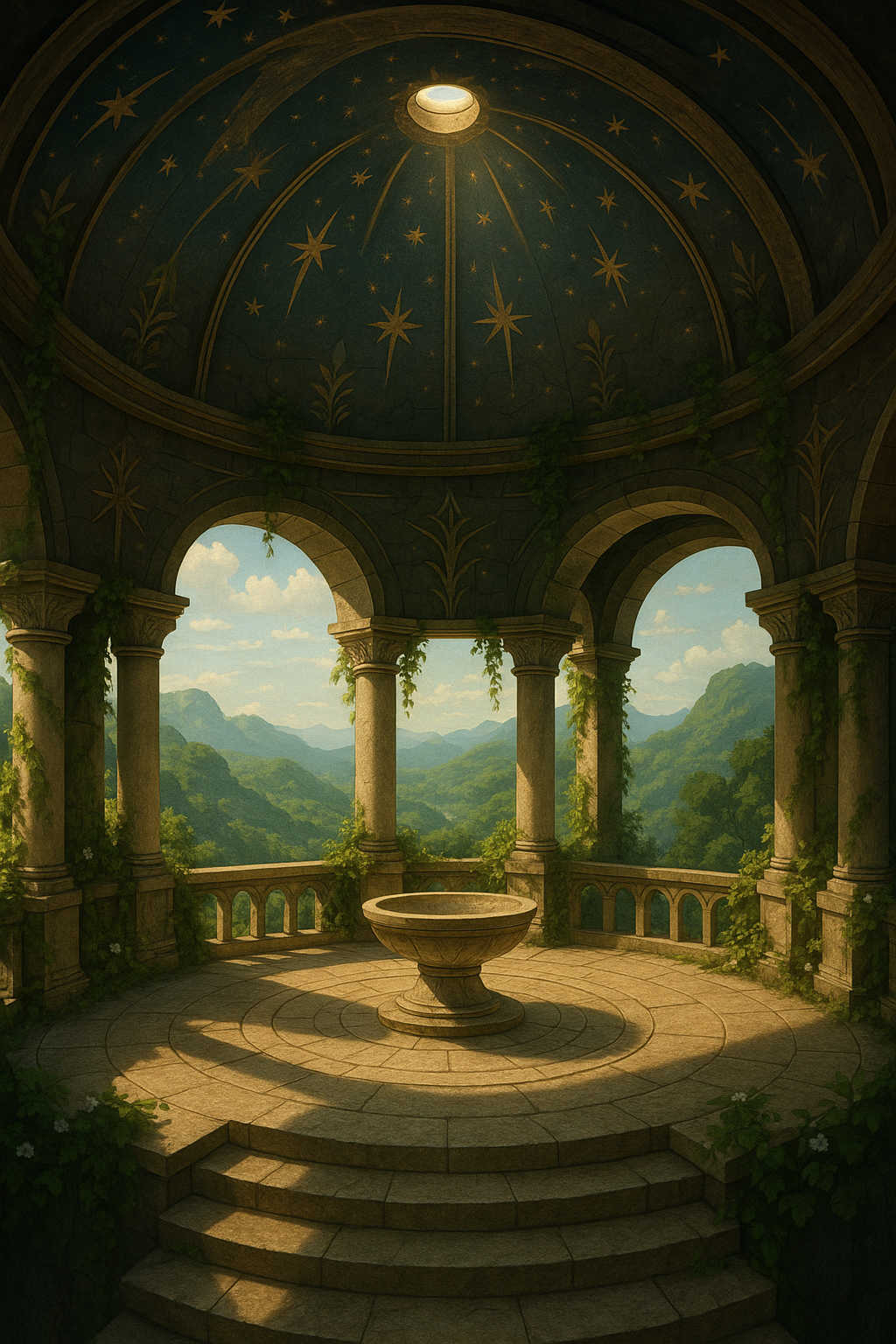The Temple of Falling Light
Perched atop one of the tallest karsts within the Cradle of the Seventy Flames, the Temple of Falling Light stands as the most sacred site in all Seraphelle history. Its rounded dome, etched with golden constellations, catches the first rays of sunrise and the glow of Callista’s moonlight, sending fractured light across the jungle canopy below. Built from pale jungle stone and inlaid with mirrored obsidian, the structure reflects the night sky as if the heavens themselves rest upon it. The temple’s circular colonnade opens to the winds, allowing meteoric light to pour into its sanctum during celestial events. At its heart lies The Emberfont, an empty basin once said to have burned with Seraphis’s divine flame. Pilgrims climb the winding stone path spiraling the karst to leave offerings beneath the dome, believing that even in its silence, the temple listens. During meteor showers, the mirrored obsidian ignites with the reflection of falling stars, turning the entire spire into a beacon of celestial fire—a reminder of the god’s descent and the enduring hope that his light will one day return.
Purpose / Function
The intended purpose of the Temple of Falling Light was, and still is, to serve as the spiritual and ceremonial heart of the Seraphelle people. Built atop the tallest karst in the Cradle of the Seventy Flames, it was designed as a place to commune with Seraphis, offer prayers, and light celestial fires during meteor showers to honor his descent. Its open dome was specifically constructed to allow the heavens to pour light directly onto the Emberfont, symbolically uniting the divine and the mortal.
The original reason for its construction, however, was more profound and somewhat different. According to Seraphelle oral tradition, the temple was built to house and protect a fragment of Seraphis’s divine flame, believed to have been left in the crater when he first walked the world. The Emberfont was not merely symbolic in its earliest days—it was said to hold a living flame that never went out, a tangible link between god and people. Priests of Seraphis tended this flame, drawing strength and prophecy from it. After Seraphis’s death, the flame extinguished, leaving the Emberfont cold and the temple’s role shifting from divine conduit to memorial and beacon of hope.
Today, while no divine fire burns, the Seraphelle still treat the temple as a sacred bridge between what was lost and what might be restored.
Architecture
The Temple of Falling Light blends Seraphelle celestial architecture with the natural features of the karst landscape. This style is characterized by rounded forms, open sanctums, and structures that integrate with their environment rather than dominate it. Domes, circular colonnades, and spiral paths mimic the cycles of stars and moons, while mirrored surfaces—crafted from polished obsidian—reflect both light and shadow, honoring their dual reverence for beauty and wisdom. The temple has minimal walls in its upper sanctum, emphasizing openness to the sky, with carved screens and archways instead of enclosed chambers.
The stone used in its construction is primarily pale Esvalnir limestone, quarried from the surrounding karst formations. This stone is light-colored and porous, weathering to a silvery hue under years of rain and moonlight. It holds chisel marks and carvings well, allowing the Seraphelle to etch star maps, meteor patterns, and divine motifs directly into the structure. Sections of the temple are inlaid with mirrored obsidian, imported from volcanic regions far beyond the crater, giving the building its iconic gleaming accents.
Wood is scarcely used in the primary structure—given the jungle’s humidity and decay—but sacred moonwood (a pale, rot-resistant timber from a rare jungle tree) is used for the inner walkways, altar supports, and ceremonial doors. Over centuries, vines and flowering plants have wound themselves into the design, blurring the line between temple and living jungle.
Founding Date
c. 112 HE
Type
Cathedral / Great temple
Parent Location
Owning Organization






Comments